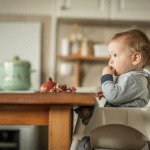
The first buds to poke through your baby’s tender gums will most likely be the bottom two, then the top two, and then the teeth will appear from the center backwards, until molars appear.
Teething can be a very painful process for some babies, you might have to bear with a few tantrums and crying throughout the teething period, and give your infant the extra attention and love during this time.
Most common symptoms of teething
- Drooling! Teething enhances salivation, and you may find your baby’s shirt soaked in saliva. Try keeping a bib on your baby and wiping away drool off his or her chin to prevent chapping.
- Teething rash caused by the constant flow of drool, which can cause the skin to become red, chapped and sore, to prevent this be sure to frequently pat dry your baby’s chin and neck, and you could use a product like Vaseline to create a barrier between the saliva and your baby’s skin
- Refusal to feed from your breast or a bottle, due to his or her tender, inflamed gums.
- Crying; your baby is likely to be unsettled and upset when teething due to discomfort.
- Flushed cheeks; your baby may display flushed, red cheeks or one cheek when teething.
- Looser stools; your baby may have a looser slimy stool when teething and possibly an upset tummy which may also result in diaper rash.
Pain relievers when teething:
- You can provide your little one with bumpy rubber teething rings or soft toys for them to bite down on to provide the pain-relieving counter pressure. These are especially effective at numbing pain if they are cool from being stored in the fridge.
- Anything else cool can help numb and sooth sore gums, including cold drinks and cold food such as blended fruit stored in the fridge.
- The pain from the pressure of the teeth trying to penetrate through the gum can be relieved by counter pressure, which is why biting is a sign of teething.








